Archaeology of the United Arab Emirates
The area currently known as the United Arab Emirates (UAE) (previously the Trucial States) was formerly populated by inhabitants of a number of coastal and inland settlements, with human remains pointing to a pattern of transmigration and settlement as far back as 125,000 years.[1] Prehistoric settlement in the UAE spanned the Neolithic, with a number of distinctive eras of ancient settlement including the Stone Age Arabian Bifacial and Ubaid cultures from 5,000 to 3,100 BCE; the Hafeet period with its distinctive beehive shaped tombs and Jemdet Nasr pottery, from 3,200 to 2,600 BCE; the Umm Al Nar period from 2,600 to 2,000 BCE; the Wadi Suq Culture from 2,000–1,300 BCE and the three Iron Ages of the UAE.
The UAE's Iron Age I spanned 1,200–1,000 BCE; Iron Age II, 1,000–600 BCE and Iron Age III from 600–300 BCE. This was followed by the Hellenistic Mleiha (or Late Pre-Islamic) era, from 300 BCE onwards through to the Islamic era which commenced with the culmination of the 7th century Ridda Wars.
The remains of settlements, burials and other extensive evidence of human habitation throughout these eras is littered throughout the UAE, with many extensive finds of rich materials in the shape of pottery, jewellery, weapons and both human and animal remains providing archaeologists and researchers with an increasingly sophisticated picture of longstanding involvement in regional trade alongside nomadic cultures eking out a living from the frequently arid and inhospitable desert and mountain environment of the UAE.
The first modern digs to take place in the Trucial States were led by teams from the Danish Moesgaard Museum in 1959[2] and focused the island of Umm Al Nar before going on to investigate the beehive tombs in and around the area of Al Ain (then often still known as Buraimi) in the emirate of Abu Dhabi.
First discovery
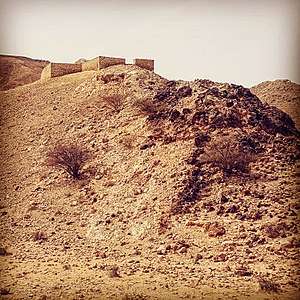
The first archaeological excavations in the UAE were in 1959, led by Peter Glob and his assistant Geoffrey Bibby. Glob was a professor at Aarhus University and director of its Moesgaard Museum. He had undertaken a series of digs in Bahrain and was contacted by the director of Abu Dhabi Marine Areas Ltd, an oil company, Temple Hillyard, who invited them to visit some graves he had found on the small island of Umm Al Nar (then referred to as Umm an-Nar), having been directed to the site by the then-Ruler of Abu Dhabi, Sheikh Shakhbut bin Sultan Al Nahyan. Hillyard had already determined that the tumuli were 'reminiscent of the Bronze Age one in Bahrain'.[3] During excavations at Umm Al Nar, the Ruler's brother, Sheikh Zayed bin Sultan Al Nahyan visited the dig and told the archaeologists that there were many more such artefacts in Al Ain. He invited them to visit him and led them to a group of some 200 burial cairns – what would later turn out to be Hafit period burials. Zayed later took members of the Danish team to other sites in the area, including a low tell which is now known as Rumailah, a significant Iron Age site.[4]
Subsequent excavations by teams from Iraq in the 1970s unveiled the Jebel Buhais site,[5] as well as the hugely significant ancient city of Ed-Dur. Since then, digs have taken place around the UAE by teams from universities in France, Spain, Germany, Jordan, Australia and the UK.
Prehistory
The Mleiha Archaeological Centre displays evidence of the oldest archaeological finds in the UAE, the prehistoric Faya-1 collection, which dates human occupation in the area to 130,000–120,000 BCE and has been linked to the movement of the first anthropologically modern humans from Africa to populate the world.[6] The Faya discovery, made in 2011, includes primitive hand-axes, as well as several kinds of scrapers and perforators, which resemble those used by early modern humans in East Africa. Through the technique of thermoluminescence dating the artefacts were placed at 125,000 years old. This is the earliest evidence of modern humans found anywhere outside Africa and implies modern humans left Africa much earlier than previously thought.[7] Mleiha is also the site of Neolithic as well as Umm Al Nar period burials,[8] and gives its name to the Hellenistic Mleiha period (now more commonly referred to as the 'late pre-Islamic period'), from 300 BCE onwards, characterised by the extensive fortified compound, 'Mleiha Fort', which was discovered in the late 1990s and is thought to have been possibly the seat of an ancient South Arabian kingdom.[9]
The oldest radiometrically dated inland burial site in the UAE is the extensive necropolis at Jebel Buhais.[10] The site, located near Madam, in Sharjah, consists of burial sites spanning the Stone, Bronze, Iron and pre-Islamic ages of human settlement in the UAE. Burials at Jebel Buhais (Jebel is Arabic for mountain) date back to the 5th millennium BCE.[11]
Arabian bifacial
During the glacial maximum period, 68,000 to 8,000 BCE, Eastern Arabia is thought to have been uninhabitable. Finds from the stone age Arabian Bifacial and Ubaid cultures (including knapped stone arrow and axe heads as well as Ubaid pottery) show human habitation in the area from 5000 to 3100 BCE. The archaeological record shows that Arabian Bifacial/Ubaid period came to an abrupt end in eastern Arabia and the Oman peninsula at 3800 BC, just after the phase of lake lowering and onset of dune reactivation.[12] There is no evidence of human presence in the area for approximately 1,000 years, the so-called "Dark Millennium".[13] This is thought to be consistent with changing patterns of human life as a result of climate change: a spring discovered at Jebel Buhais dried up at this stage, an event contemporaneous with similar discoveries pointing to increased aridity in the interior of Oman. Throughout Southern Arabia, evidence of human inland settlement in the 3rd millennium BCE is scant.[14]
Ed-Dur
One of the most significant archaeological sites in the UAE is that at Ed-Dur, an Ancient Near Eastern City located in Umm Al Qawain.[15] One of the largest sites in the country, comprising an area of some five kilometres, the coastal settlement overlooks the Al Beidha Lake. It has been dubbed 'one of the most significant lost cities of Arabia'.[16] It was first discovered by an Iraqi archaeological team in 1973 and first dug in 1974.[17] Subsequent digs have unearthed evidence of human habitation spanning the Ubeid period, Stone Age, Bronze Age, Iron Age, and Pre-Islamic period. During the latter period the settlement appears to have been at its most prosperous and the hills of the area were entirely covered with dozens of buildings and thousands of stone-built tombs. Some 500 of these tombs have been excavated,[17] with grave goods discovered including drinking sets, Roman glass, weaponry, pottery, jewelry and ivory objects.[18] It is thought some 20,000 tombs are on the site in all.[19] Similarly, the necropolis of Jebel Buhais spans a remarkable period, with burials evident as far back as the fifth millennium BCE,[20] while Mleiha also represents human settlement dating back some 7,000 years.[10]
Hafit period
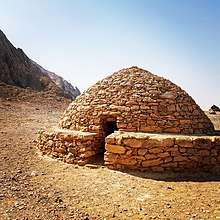
The Hafit period is marked by (and named for) the distinctive 'beehive' tombs first discovered around the area of Jebel Hafit in Al Ain. The period defines early Bronze Age human settlement in the United Arab Emirates and Oman in the period from 3,200 to 2,600 BC. Hafit period tombs and remains have also been located across the UAE and Oman in sites such as Bidaa bint Saud,[21] Jebel Buhais and Buraimi[22] in the UAE and Bat, Al-Khutm and Al-Ayn in Oman.
The first find of Hafit era tombs is attributed to the Danish archaeologist P.V. Glob of the Moesgaard Museum (who also investigated Umm Al Nar) in 1959, and the first of many excavations of these took place a few years later.[2] uncovering the remains of some 317 circular stone tombs and settlements from the Hafit period, as well as wells and partially underground falaj irrigation systems, and mud brick constructions intended for a range of defensive, domestic and economic purposes. The Al Ain Oasis, in particular, provides evidence of construction and water management enabling the early development of agriculture for five millennia, up until the present day.[23]
Pottery finds at Hafit period sites demonstrate trading links to Mesopotamia, contiguous to the Jemdat Nasr period (3100–2900 BC).[2] Evidence of trading links with Mesopotamia are also found in the subsequent Umm Al Nar and Wadi Suq periods of UAE history.[24]
Umm Al Nar period
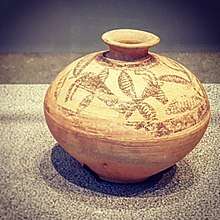
The Bronze Age Umm Al Nar period spans the period 2600–2000 BCE. The name is derived from the first excavations which took place at Umm Al Nar, an island on the coast of Abu Dhabi, in 1959. The distinctive circular tombs of the Umm Al Nar period distinguish it from the preceding Hafit period, together with finds of distinctive black on red decorated pottery and jewellery made with gems such as carnelian, sourced from the Indus Valley.[25]
Seven tombs from a total of fifty and three areas at the ruins of the ancient settlement were examined by the Danish archaeologists in the 1959 season. During their first visit they identified a few exposed shaped stones fitted together at some of the stone mounds. The following year, the first excavations started at one of the mounds on the plateau, now called Tomb I. Two more seasons (1960 and 1961) involved digging more tombs, while the last three seasons (1962–63, 1964 and 1965) were allocated to examining the settlement.[26]
The Danish excavations at Umm Al Nar halted in 1965 but work resumed in 1975 by an archaeological team from Iraq. During the Iraqi excavations which lasted one season, five tombs were excavated and a small section of the village was examined. Between 1970 and 1972 an Iraqi restoration team headed by Shah Al Siwani, former member of the Antiquities Director in Baghdad, restored and/or reconstructed the Danish excavated tombs.[26]
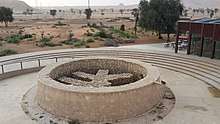
At Al Sufouh Archaeological Site in Dubai, archaeological excavation between 1994 and 1995, revealing an Umm Al Nar type circular tomb dating between 2500 and 2000 B.C. Dubai Municipality and the Sanisera Archaeology Institute conducted excavations at the site of Al Ashoosh between November 2015 and May 2016. The site was discovered during two seasons of survey in 2002–2003 following the discovery of the nearby Iron Age metallurgical centre Saruq Al Hadid, and is located 8 km from that site.[27]
Surveys in the area by Dubai Municipality and the Department of Antiquities of Jordan identified 33 archaeological sites ranging in date from prehistory to the late Islamic period. In 2006–2007, more-detailed archaeological investigations of the area of Al-Ashoosh were conducted, including survey, excavation and geological sampling.[28]
At Tell Abraq, settlements associated with the start of the Umm Al Nar culture began c. 2500 BC. Finds at Shimal and Ed Dur also point to a transitional period between the Umm Al Nar and following Wadi Suq periods. The excavations at Shimal, principally those of the mid-1980s by a team from the University of Göttingen in Germany, are significant as they provided early evidence of the 'Wadi Suq' period, including finds of pottery, soft-stone vessels, bronze and copper weapons and beads which came to be regarded as typical of the period c. 2000–1300 BC in the UAE.[29]
Wadi Suq period
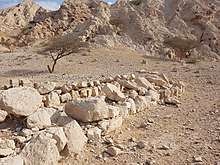
The Wadi Suq culture flourished in the period from 2,000 to 1,300 BCE. It takes its name from a wadi, or waterway, East of Sohar in Oman. Rather than a seismic cultural shift, a gradual change in human society which is centred around more sophisticated approaches to animal husbandry, particularly the domestication of the camel,[30] as well as changes in the surrounding trade and social environments, took place between the Umm Al Nar and Wadi Suq periods. The transition between Umm Al Nar and Wadi Suq is thought to have taken some 200 years and more, with finds at the important Wadi Suq site of Tell Abraq in modern Umm Al Quwain showing evidence of the continuity of Umm al-Nar burials.[30] At Qattara Oasis in Al Ain, the Wadi Suq communal tomb is thought to have been constructed from stones recovered from previous Umm Al Nar burials.[31]
Evidence of increased mobility among the population points to a gradual change in human habits rather than sudden change[32] and important Wadi Suq era sites such as Tell Abraq, Ed Dur, Seih Al Harf, Shimal and Kalba show an increasing sophistication in copper and bronze ware as well as trade links both east to the Indus Valley and west to Mesopotamia.[33]
Changes in two important trading partners also took place during this period, with the Mesopotamian city of Ur falling to Elam in 2,000 BC and the decline of the Indus Valley Harappan Culture in 1,800 BC. The abandonment of the port of Umm Al Nar took place at around this time.[34]
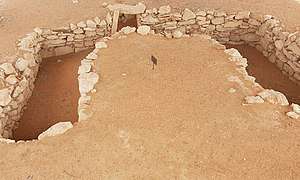
The Wadi Suq site at Seih Al Harf in Ras Al Khaimah was first excavated by a team from the University of Durham, led by Derek Kennet, in the spring of 2013. The site comprises a series of 50 burial sites, of which two were directly threatened by road development, an 18-metre horseshoe shaped and a W-shaped tomb. Both were collective graves. Ten other excavated features were also impacted by the road development.[35] Although the site was seen to be threatened by the development of the northern extension of the arterial Emirates Road (E611), with proposals tabled to amend the road development to avoid damage to the site,[35] the road project went ahead.[36]
A number of Wadi Suq and Iron Age discoveries were made in the mountain village of Bithnah in Fujairah, first excavated by the Swiss-Liechtenstein Foundation for Archaeological Research Abroad (SLFA) between 1987 and 1991. Presided over by Prince Hans-Adam II of Liechtenstein, and directed in the field by Pierre Corboud, the SLFA team conducted several seasons of survey in the mountainous inland area of Fujairah, including the excavations at Bithnah, where a communal grave site was uncovered as well as a number of Iron Age finds.[37] There have also been excavations by teams from the University of Geneva and French National Research Centre. Significant Iron Age finds have been made throughout the area, including a number of petroglyphs.[38]
Iron Age
From 1,200 BC to the advent of Islam in Eastern Arabia, through three distinctive Iron Ages (Iron Age 1, 1200–1000 BC; Iron Age II, 1000–600 BC and Iron Age III 600–300 BC) and the Hellenistic Mleiha period (300 BC onward), the area was variously occupied by Archaemenid and other forces and saw the construction of fortified settlements and extensive husbandry thanks to the development of the falaj irrigation system (also called qanat). Early finds of aflaj, particularly those around the desert city of Al Ain, have been cited as the earliest evidence of the construction of these waterways.[39] It is thought nearby Bidaa bint Saud became an important site during the Iron Age, both as a caravan stop and as a settled community of farmers that used the falaj irrigation system there.[40] Two of these irrigation passages have been partly excavated at Bidaa bin Saud, with a number of sections remaining in reasonable condition. In one of the excavations, a number of sandstone-lined shaft holes were discovered, as well as a stepped underground access point and a large open cistern. Evidence of formerly irrigated land has also been found at the site.[41]
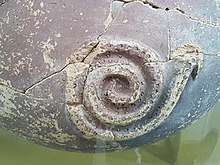
Important Iron Age centres in the UAE have rendered an unusual richness in finds to archaeologists, particularly the spectacular metallurgical centre of Saruq Al Hadid in what is today Dubai. Other important Iron Age settlements in the country include Al Thuqeibah, Madam, Bidaa bint Saud, Ed-Dur and Tell Abraq.[42][43][44][40]
Iron Age burials at Jebel Buhais, particularly the group of graves defined as BHS 85, are thought to be linked to the nearby Iron Age settlement site of Al Thuqeibah.[20] The site was originally excavated by teams from the Autonomous University of Madrid in the mid-1990s. Thuqeibah has been dated from the Iron Age II and III periods (1100–400 BC). A settlement consisting of a number of houses and a well, it has been associated with a nearby Iron Age falaj system,[45] thought to date from the Iron Age II era.[46] 1st Millennium aflaj have also been unearthed at nearby Al Madam.[47]
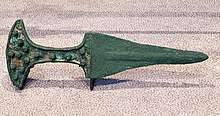
The site of Rumailah, in Al Ain, like many in the UAE spans a wide period with finds dating back to the Umm Al Nar period, but shows a flourishing during the Iron Age. Finds at Rumailah include distinctive pottery adorned with snake patterns, similar to finds at Qusais, Masafi and the major Iron and Bronze Ages; metallurgical production centre at Saruq Al Hadid, as well as chlorite vessels decorated with turtles alternating with trees, similar to finds from Qidfa' in Fujairah, Qusais in Dubai and Al-Hajar in Bahrain. A number of Iron Age swords and axe-heads, as well as distinctive seal moulds, were also recovered from the site. A number of bronze arrowheads were also found at the site. The Iron Age buildings found at Rumailah are typical of those found in the region, at Iron Age I and II sites such as Al Thuqeibah and Muweilah, with a number of row dwellings, although lacking the perimeter walls found at Thuqeibah.[48] A columned hall at Rumailah provides a further link to Muweilah, while a number of pyramidal seals found at Rumailah find an echo with similar objects discovered at Bidaa bint Saud.[49]
One of the most significant Iron Age sites in the UAE is Muweilah, located in the Sharjah suburb of Al Jurainah, near Sharjah University City. A large, fortified settlement thought to have been occupied during the Iron Age II period (1100–600BC), the site has been explored by archaeologists since an Australian expedition started work there in 1994 after the discovery of pottery shards by a local resident. It has yielded the oldest known example of writing found to date in the UAE, a pottery shard with an inscription, thought to be Sabean, with the letters 'bml'.[50]
Saruq Al Hadid
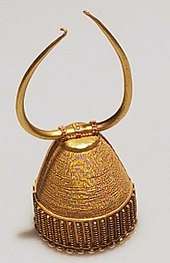
The Saruq Al Hadid site in the desert south of Dubai was a centre of constant human habitation, trade and metallurgy from the Umm Al Nar period (2600–2000 BCE) to 1,000 BCE, when it was a major location for smelting bronze, copper and Iron.[51] Arguably its most important period of flourishing was as a metallurgical centre in the Iron Age II period (1100–600 BCE). One of the many thousands of finds to be documented at the site was an ornate gold ring, which became the inspiration for Dubai's Expo 2020 logo.[52]
Some of the many enigmas surrounding the site are its location far from sources of water, ore or firewood, all critical elements to a metallurgical centre. An abundance of pottery and metal artifacts have given rise to speculation of possibly identifying the site as a centre of snake worship. In all, over 12,000 unique objects have been unearthed at the site.[53] A number of key finds are on public display at Dubai's Saruq Al Hadid Archaeology Museum in Al Shindagha, housed in a traditional barjeel (wind tower) building constructed in 1928 by Sheikh Juma bin Maktoum Al Maktoum.[54]
Post Islamic finds
Archaeologists have worked on post-Islamic era sites across the UAE, particularly in Ras Al Khaimah (the coastal settlement of Julphar) and the East Coast. On the East Coast, in Fujairah, the village of Bidayah has been the focus of a number of explorations of its mosque and the remains of a Portuguese fort, discovered in the village by a team of Australian archaeologists. The fort, originally called 'Libidia', was identified from a 16th-century map. Its walls were constructed using rock recovered from a nearby tower dated back to the third millennium BCE.[55] These walls, some 60 metres in length, are joined in a square with towers on each corner and stand today at a height of up to a meter. Finds at the site of the fort include locally made pottery dating back to the 17th and 18th centuries and charcoal samples unearthed were carbon dated to 1450–1600, within the context of the Portuguese presence in the Gulf.[56]
The Bidayah mosque's date of construction is uncertain[57] and because the mud and stone built structure uses no wood, radiocarbon dating is not possible. It is estimated to date to the 15th century,[58] however some much earlier estimates have been proposed.[59] The site was investigated by the archaeological center of Fujairah in co-operation with the University of Sydney from 1997–98.[59] and Fujairah Archaeology and Heritage Department came up with the conclusion that the mosque was believed to be built in 1446 AD, along with the two watch towers overlooking the mosque and the village.[57]
References
- "New timeline for first early human exodus out of Africa | EarthSky.org". earthsky.org. Retrieved 2018-09-05.
- Magee, Peter (2014), The Archaeology of Prehistoric Arabia, Cambridge University Press, pp. 275–278, doi:10.1017/cbo9781139016667.011, ISBN 9781139016667
- Hellyer, Edited by Daniel T. Potts & Peter (2012). Fifty years of Emirates archaeology: proceedings of the Second International Conference on the Archaeology of the United Arab Emirates. Abu Dhabi. pp. 12, 13. ISBN 9781860633232. OCLC 1004865536.CS1 maint: extra text: authors list (link)
- Hellyer, Edited by Daniel T. Potts & Peter (2012). Fifty years of Emirates archaeology: proceedings of the Second International Conference on the Archaeology of the United Arab Emirates. Abu Dhabi. pp. 16, 17. ISBN 9781860633232. OCLC 1004865536.CS1 maint: extra text: authors list (link)
- Near Eastern Archaeology in the Past, Present and Future. Germany: Harrassowitz Verlag. 2010. p. 42. ISBN 978-3447061759.
- "Dh250m for Mleiha archaeological project | The National". www.thenational.ae. Retrieved 2016-04-03.
- "New timeline for first early human exodus out of Africa | EarthSky.org". earthsky.org. Retrieved 2018-11-18.
- "First phase of Mleiha Archaeological and Eco-tourism Project opened". Sharjah Update. 2016-01-27. Retrieved 2016-04-03.
- UAEINTERACT. "UAE Interact, United Arab Emirates information, news, photographs, maps and webcams". www.uaeinteract.com. Retrieved 2016-04-03.
- Kiesewetter, Henrike (1999). "Neolithic jewellery from Jebel al-Buhais 18". Proceedings of the Seminar for Arabian Studies. 30: 137–146. JSTOR 41223703.
- "Jebel al-Buhais. Art Destination Sharjah". universes.art. Retrieved 2018-04-18.
- Parker, Adrian G.; et al. (2006). "A record of Holocene climate change from lake geochemical analyses in southeastern Arabia" (PDF). Quaternary Research. 66 (3): 465–476. doi:10.1016/j.yqres.2006.07.001. Archived from the original (PDF) on September 10, 2008.
- Uerpmann, M. (2002). "The Dark Millennium—Remarks on the final Stone Age in the Emirates and Oman". In Potts, D.; al-Naboodah, H.; Hellyer, P. (eds.). Archaeology of the United Arab Emirates. Proceedings of the First International Conference on the Archaeology of the U.A.E. London: Trident Press. pp. 74–81. ISBN 978-1-900724-88-3.
- Potts, Daniel (2003). Archaeology of the United Arab Emirates. UK: Trident Press. pp. 74. ISBN 978-1900724883.
- Centre, UNESCO World Heritage. "Ed-Dur Site - UNESCO World Heritage Centre". whc.unesco.org. Retrieved 2017-10-26.
- "Ancient Cities of the Emirates". Beyond Dubai: Seeking Lost Cities in the Emirates by David Millar. Archived from the original on 2017-10-26. Retrieved 2017-10-26.
- "500 tombs dating back 2,000 years found in Umm Al Quwain". The National. Retrieved 2017-10-26.
- UAEINTERACT. "UAE Interact, United Arab Emirates information, news, photographs, maps and webcams". www.uaeinteract.com. Retrieved 2017-10-26.
- "Slowly solving riddles of the UAE's ancient ed-Dur". The National. Retrieved 2017-10-26.
- Uerpmann, Hans Peter (2006). Funeral Monuments and Human Remains from Jebel al-Buhais. UAE: UAE Ministry of Culture and Information. p. 9. ISBN 978-3-935751-06-3.
- Editor, Samir Salama, Associate (2011-12-30). "Al Ain bears evidence of a culture's ability to adapt". GulfNews. Retrieved 2018-07-16.CS1 maint: extra text: authors list (link)
- Christopher P. Thornton; Charlotte M. Cable; Gregory L. Possehl (2016). The Bronze Age Towers at Bat, Sultanate of Oman. University of Pennsylvania Press, Inc. pp. i–vi. doi:10.2307/j.ctv2t4ct6.1. ISBN 978-1-9345-3607-0.
- "Cultural Sites of Al Ain (Hafit, Hili, Bidaa Bint Saud and Oases Areas)". UNESCO World Heritage Centre. Retrieved 2018-07-16.
- United Arab Emirates : a new perspective. Abed, Ibrahim., Hellyer, Peter. London: Trident Press. 2001. pp. 43. ISBN 1900724472. OCLC 47140175.CS1 maint: others (link)
- United Arab Emirates : a new perspective. Abed, Ibrahim., Hellyer, Peter. London: Trident Press. 2001. pp. 46. ISBN 1900724472. OCLC 47140175.CS1 maint: others (link)
- Hojlund, Flemming (1999). Glob and the Garden of Eden, the Danish Expeditions to the Arabian Gulf. Moesgard Museum. ISBN 978-8787334327.
- Herrmann, Jason T.; Casana, Jesse; Qandil, Hussein Suleiman (2012-04-09). "A sequence of inland desert settlement in the Oman peninsula: 2008-2009 excavations at Saruq al-Hadid, Dubai, UAE". Arabian Archaeology and Epigraphy. 23 (1): 50–69. doi:10.1111/j.1600-0471.2011.00349.x. ISSN 0905-7196.
- Contreras, F.; Carcacer, N.; Thomas, J.; Koljic, D.; Murray, M.; Bukhash, R. M.; Abbar, S. O. Al; Boraik, M.; Zein, H. M. (2016). "Al-Ashoosh: a third-millennium BC desert settlement in the United Arab Emirates". Antiquity. 90 (354): 1. doi:10.15184/aqy.2016.219. ISSN 0003-598X.
- UAEINTERACT. "UAE Interact, United Arab Emirates information, news, photographs, maps and webcams". www.uaeinteract.com. Retrieved 2017-12-05.
- "Societal changes in Bronze Age Arabia... here's the tooth in the matter". The National. Retrieved 2017-12-05.
- 1928-2013., Rice, Michael (1994). The archaeology of the Arabian Gulf, c. 5000-323 BC. London: Routledge. p. 247. ISBN 978-0203037263. OCLC 252810506.CS1 maint: numeric names: authors list (link)
- Carter, R. (1997). "The Wadi Suq period in south-east Arabia: a reappraisal in the light of excavations at Kalba, UAE". Proceedings of the Seminar for Arabian Studies. 27: 87–98. JSTOR 41223590.
- 1968-, Magee, Peter (2014-05-19). The archaeology of prehistoric Arabia : adaptation and social formation from the neolithic to the iron age. New York. ISBN 9780521862318. OCLC 852824778.CS1 maint: numeric names: authors list (link)
- 1963-, Hawker, Ronald William (2008). Traditional architecture of the Arabian Gulf : building on desert tides. Southampton, UK: WIT. ISBN 9781845641351. OCLC 191244229.CS1 maint: numeric names: authors list (link)
- Reporter, Sara Sabry, Staff (2013-04-05). "Ancient graves unearthed in RAK". GulfNews. Retrieved 2018-09-06.
- "Archaeologists make last ditch attempt to rescue remains of pre-historic tombs in RAK". The National. Retrieved 2018-09-06.
- Corboud, Pierre (1994). Archaeological Survey of Fujairah, 3 (1993): Preliminary Report of the 1993 Campaign of the Archaeological Survey of Fujairah (United Arab Emirates), Volume 3. Berne: Swiss-Liechtenstein Foundation for Archaeological Research Abroad, 1994.
- "Campus Magazine" (PDF). University of Geneva Campus Magazine. University of Geneva. 1996. Retrieved 10 February 2017.
- TIKRITI, WALID YASIN AL (2002). "The south-east Arabian origin of the falaj system". Proceedings of the Seminar for Arabian Studies. 32: 117–138. JSTOR 41223728.
- Editor, Samir Salama, Associate (2011-12-30). "Al Ain bears evidence of a culture's ability to adapt". GulfNews. Retrieved 2018-07-31.CS1 maint: extra text: authors list (link)
- Angelakis, Andreas Nikolaos; Chiotis, Eustathios; Eslamian, Saeid; Weingartner, Herbert. Underground aqueducts handbook. Boca Raton. ISBN 978-1-3153-6856-6. OCLC 966358839.
- P. Hellyer, New finds at Tell Abraq. Tribulus (Journal of the Emirates Natural History Group), vol. 2, no.1, pp.15-17, 1992
- United Arab Emirates : a new perspective. Abed, Ibrahim., Hellyer, Peter. London: Trident Press. 2001. pp. 49. ISBN 1900724472. OCLC 47140175.CS1 maint: others (link)
- Cerro, Carmen (2013). "Biological Remains at Al Madam (Sharjah, UAE)" (PDF). Bioarchaeology of the Near East: 23, 24.
- Mouton, Benoist, Cordoba (June 2011). "The Snake Figuration in Iron Age Society" (PDF). Liwa: 16–18.CS1 maint: multiple names: authors list (link)
- Cerro, Carmen (2013). "Biological Remains at Al Madam (Sharjah, UAE)" (PDF). Bioarchaeology of the Near East: 23, 24.
- "Another ancient Sharjah site found by archaeologists". The National. Retrieved 2018-04-15.
- Potts, Daniel T.; Nābūdah, Ḥasan Muḥammad; Hellyer, Peter (2003). Archaeology of the United Arab Emirates. London: Trident Press. pp. 174–177. ISBN 978-1-9007-2488-3. OCLC 54405078.
- Potts, Daniel T.; Naboodah, Hasan Al; Hellyer, Peter (2003). Archaeology of the United Arab Emirates. Potts, Daniel T.,, Nābūdah, Ḥasan Muḥammad,, Hellyer, Peter. London. pp. 188. ISBN 978-1900724883. OCLC 54405078.
- Heritage, Sharjah Directorate of Antiquities &. "Muweilah – Sharjah Directorate of Antiquities & Heritage". sharjaharchaeology.com. Retrieved 2017-12-04.
- "SHARP – the Saruq al-Hadid Archaeological Research Project". Research Plus. 2017-09-03. Retrieved 2018-07-29.
- "The story behind the new Dubai Expo 2020 logo - What's On Dubai". What's On Dubai. 2016-03-28. Retrieved 2018-07-29.
- Report, Gulf News Web (2016-11-04). "Know the UAE: Archaeological site found south of Dubai shows key aspects of life in Iron Age Arabia". GulfNews. Retrieved 2018-07-29.
- "Saruq Al-Hadid Archaeological Museum Official Website". Retrieved 2018-07-29.
- United Arab Emirates : a new perspective. Abed, Ibrahim., Hellyer, Peter. London: Trident Press. 2001. pp. 92. ISBN 978-1900724470. OCLC 47140175.CS1 maint: others (link)
- Ziolkowski, Michelle (Winter 1999). "Excavations at al-Bidiyya: new light on the Portuguese presence in the Emirates". Tribulus: 19–20.
- "Designs on the past". Gulf News. December 10, 2001. Retrieved August 1, 2011.
- Harnan, Eugene (August 21, 2011). "Oldest UAE mosque holds onto its secrets". The National. Retrieved June 9, 2019.
- "The oldest mosque in the country". The National. December 4, 2010. Retrieved April 18, 2011.